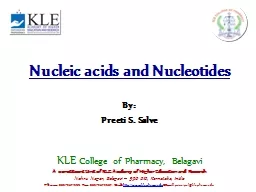

By Preeti S Salve KLE College of Pharmacy Belagavi A constituent Unit of KLE Academy of Higher Education and Research Nehru Nagar Belagavi 590 010 Karnataka India Phone ID: 929910
Download Presentation The PPT/PDF document "Nucleic acids and Nucleotides" is the property of its rightful owner. Permission is granted to download and print the materials on this web site for personal, non-commercial use only, and to display it on your personal computer provided you do not modify the materials and that you retain all copyright notices contained in the materials. By downloading content from our website, you accept the terms of this agreement.
Slide1
Nucleic acids and Nucleotides
By: Preeti S. Salve
KLE
College of Pharmacy,
Belagavi
A constituent Unit of KLE Academy of Higher Education and Research
Nehru Nagar,
Belagavi
–
590 010, Karnataka, India
Phone:
0831-2471399;
Fax:
0831-2472387;
Web:
http
://
www.klepharm.edu
E
-mail:
principal@klepharm.edu
Slide2Nucleic acids
Nucleic acids are required for the storage and expression of genetic informationTwo types –Deoxyribonucleic acid (DNA)Ribonucleic acid (RNA)
Slide3Functions of nucleic acids
DNA is the chemical basis of heredity and may be regarded as the reserve bank/repository of genetic informationIt has maintained the identity of different species
of organisms over millions of
years
DNA controls all the cellular functions
DNA
is
organized
into
genes
-
the
fundamental
units
of
genetic
information
Slide4Genes control the protein synthesis through the mediation of RNA
The interrelationship between DNA, RNA and proteins constitutes the central dogma of molecular biology or the central dogma of life
Slide5Components of nucleic acids
Nucleic acids are the polymers of nucleotides held by 3' and 5' phosphate bridgesNucleotides (monomeric units) are building blocks of nucleic acids
Slide6NUCLEOTIDES
Nucleotide = nitrogenous base + pentose sugar + phosphateNucleoside = base + sugarTherefore, nucleotide = nucleoside + phosphate
Slide7Nitrogenous bases are aromatic heterocyclic compounds
They are of two types - purines and pyrimidinesPurines - Numbered anticlockwisePyrimidines
- Numbered clockwise
Slide8Structures
Purines
Pyrimidines
Slide9DNA contains thymine (T) whereas RNA contains
uracil (U)Purines and pyrimidines with oxo
functional group exist as tautomers
Slide10Sugars of nucleic acids
RNADNA
Slide11Bases in nucleic acids
AdenineGuanine CytosineUracil
RNA
DNA
Adenine
Guanine
Cytosine
Thymine
Slide12Cyclic nucleotides
Slide13Biological significance of nucleotides
Nucleotides serve as monomeric precursor of RNA and DNAPurine nucleotides serve as
hihgh energy sources e.g. ATPPurine nucleotides form regulatory signals e.g. cyclic AMP
Purine
nucleotides act as components of coenzymes e.g. FAD, NAD, etcPyrimidine nucleotides serve as high energy intermediates e.g. UDP glucose and UDP galactose in carbohydrate metabolism and CDP-acyl
glycerol in lipid synthesis
Slide14Nucleic acids
DNA (Deoxyribonucleic acid)RNA (Ribonucleic acid)
Slide15DNA
It is a polymer of deoxyribonucleotidesComposed of monomeric units namely
deoxyadenylate (dAMP), deoxyguanylate
(dGMP),
deoxycytidylate (dCMP) and deoxythymidylate (dTMP
)
The
monomeric
deoxvnucleotides
in DNA are held together by 3',5'-phosphodiester bridge
Slide16Slide17Chargaff’s rule of DNA composition
Erwin Chargaff (1940) observed that -DNA had equal no. of adenine and thymine residues (A=T)And equal no. of guanine and cytosine residues (G=C)This rule is followed only by double stranded DNA and RNA
Not followed by single stranded DNA and RNA
Slide18DNA double helix
The double helical structure of DNA was proposed by lames Watson and Francis Crick in 1953 (Nobel Prize, 1962)
Slide19Slide20Denaturation
of DNA strandsThe two strands of DNA helix are held together by hydrogen bonds Disruption of hydrogen bonds (by change in pH or increase in temperature) results in the separation of
polynucleotides strandsThis phenomenon of loss of helical structure of DNA is known as
denaturation
Renaturation (reannealing) - separated complementary DNA strands can form a double helix
Slide21The two strands of DNA helix are held together by hydrogen bonds
Disruption of hydrogen bonds (by change in pH or increase in temperature) results in the separation of polynucleotides strandsThis phenomenon of loss of helical structure of DNA is known as denaturation
Slide22RNA
RNA is a polymer of ribonucleotides held together by 3',5'-phosphodiester bridges
Slide23Types of RNA
1. Messenger RNA (mRNA) : 5-10%2. Transfer RNA (IRNA) : 10-20%3. Ribosomal RNA (rRNA) : 50-80%
Slide24PURINE BIOSYNTHESIS
Many compounds contribute to the purine ring of the nucleotides
Slide25Slide26Slide27Slide28Synthesis of AMP and GMP
Slide29CATABOLISM OF NUCLEOTIDES
Degradation of purine nucleotidesThe end product of
purine metabolism in humans is uric acid
Slide30Slide31Slide32Disorders of
purine metabolismNormal concentration of uric acid in the serum of adults is in the range of 3-7 mg/dlHyperuricemia refers to an elevation in the serum uric acid concentration
Gout is a metabolic disease associated with overproduction of uric acid
Slide33Primary gout:
It is an inborn error of metabolism due to overproduction of uric acid This is mostly related to increased synthesis of purine nucleotidesSecondary gout: It is due to various diseases causing increased synthesis or decreased excretion of uric acid
Increased degradation of nucleic acids (hence more uric acid formation) is observed in various cancers (leukemias, polycythemia, lymphomas, etc.) psoriasis and increased tissue breakdown (
trauma,starvation etc
.
Slide34Treatment of gout
Drug of choice for the treatment of primary gout is allopurinolIt is a structural analog of hypoxanthine that competitively inhibits the enzyme xanthine oxidaseAllopurinol
is further oxidized to alloxanthine by xanthine oxidaseAlloxanthine
, in turn, is a more effective inhibitor of xanthine oxidaseThis is termed as
suicide inhibition
Slide35